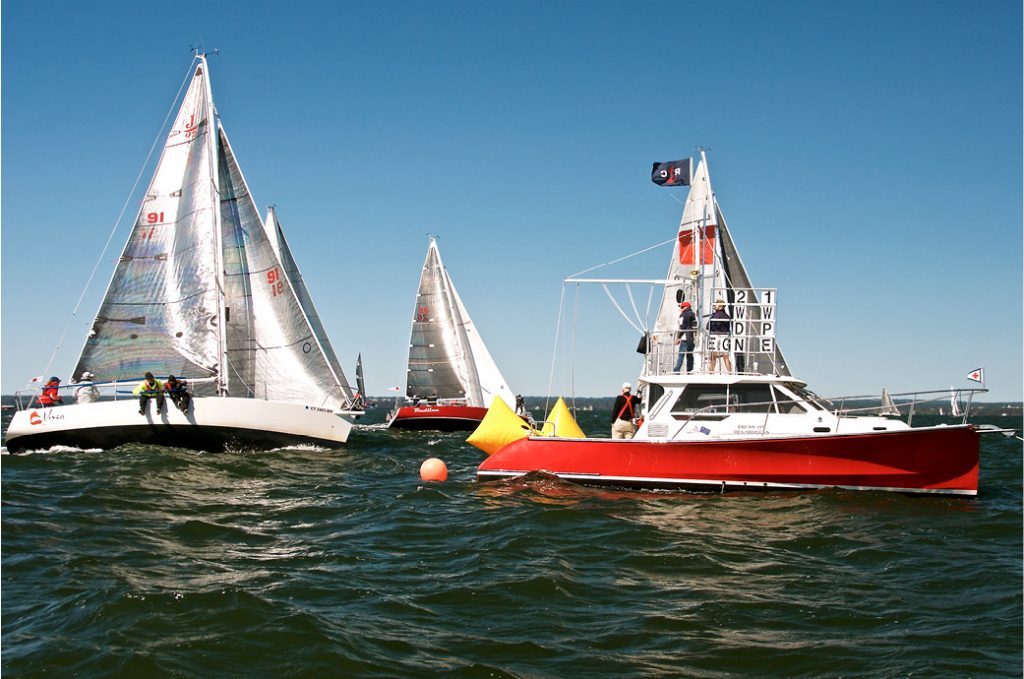Race committees usually try to set their finish lines square to the wind direction, but windshifts and other factors often skew the line and favor one end. It’s not uncommon for this favored end to be two or more boatlengths closer, and when you’re trying to gain every inch to beat your competition, this can make a huge difference.
Theoretically, a good way to understand the orientation of any finish line is by visualizing “ladder rungs,” or imaginary lines drawn on the water perpendicular to the wind direction. At an upwind finish, the favored end is the one on the lower ladder rung (since you are climbing up the ladder and you’ll get to this one first). At a downwind finish, the favored end is on the higher ladder rung. In practice, however, you can’t see ladder rungs, so it’s not always easy to identify the favored end of the finish line.
Here are a few ideas:
• Watch where other boats go. This is a very good guide but, of course, it won’t work unless you have another fleet, or some boats from your own fleet, ahead of you. Keep a close eye on where these boats finish. If almost every one goes to the pin, for example, there’s a good chance that end is favored. Pay special attention to where the better sailors finish and which end is chosen by boats that finish very close together.

One way to determine the favored end of the finishing line is to look at the angle of boats as they cross the line. Unless the line is square, one tack (port or starboard) will be more perpendicular to the line. © Rick Bannerot/OntheFlyPhoto.net
• Remember the starting line. Sometimes the race committee leaves the starting line untouched and uses it for the finish line. This makes your job a little easier. If you are finishing downwind, go to the end that was favored at the start. For an upwind finish, head for the end that wasn’t favored. Of course, you must consider windshifts that have occurred since the start and the possibility that the RC may have moved the line when you weren’t looking!
• Check out the finish line during the race. Often the race committee sets the finish line while you are in the middle of your race. If you happen to sail by the finish on a different leg, take a good look. Which end looks better? If you have a hard time judging the favored end of a finish line, think of it as a starting line. Often it’s easier to figure out the favored end for starting – then use that info for finishing.
Another method I use is to look for the tack (port or starboard) that is more perpendicular to the finish line. If boats sail more directly across the line on starboard tack, for example, then the port end of the line is favored, and vice versa.
• Wait until you are closer. If you can’t use any of the above techniques, don’t make a decision about the favored end until you get a better look at the finish line. You can postpone this decision as long as you don’t overstand either end of the finish line. If you go past the layline to either end and that end turns out to be favored, you’ll lose distance.
Your last chance to make a decision is when you get to the intersection of both laylines. At this point, the end that is closer to you is also favored, so keep going or tack toward that end. This technique works with finishes that are downwind as well as upwind. ■
This article originally appeared in David Dellenbaugh’s Speed & Smarts, The newsletter of how-to tips for racing sailors. If you want to sail faster and smarter, log onto SpeedandSmarts.com.
A resident of Easton, CT, Dellenbaugh was tactician and starting helmsman for America3’s successful defense of the America’s Cup in 1992. He’s a Lightning World Champion, two-time Congressional Cup winner, seven-time Thistle National Champion, two-time winner of the Canada’s Cup, three-time Prince of Wales U.S. Match Racing Champion, and a winner of the U.S. Team Racing Championships for the Hinman Trophy.




